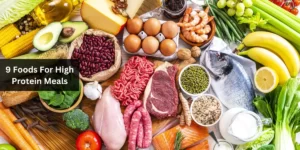When it comes to raising healthy and happy toddlers, nutrition plays a crucial role. A well-balanced diet is essential to support their rapid growth and development. High-fiber foods are not only beneficial for adults but are also vital for the youngest members of our families. In this article, we’ll explore the 10 best high-fiber foods for toddlers, ensuring that they get the nutrition they need in a delicious and enjoyable way.
Understanding the Importance of High-Fiber Foods for Toddlers
Toddlers are at a critical stage of development, both physically and mentally. Their nutritional needs are different from those of adults, and one important aspect is dietary fiber. Fiber aids in digestion, helps maintain a healthy weight, and supports overall well-being. Including fiber-rich foods in your toddler’s diet is a smart choice for their long-term health.
1. Apples: A Crunchy Delight

Apples are a fantastic source of dietary fiber for toddlers. They are not only delicious but also rich in vitamins and antioxidants. The fiber in apples promotes healthy digestion and helps prevent constipation, a common issue among toddlers. Encourage your little one to enjoy apple slices as a snack or add them to oatmeal for a nutritious twist.
2. Whole-Grain Cereals: Breakfast Boost

Starting the day with whole-grain cereals is an excellent way to increase your toddler’s fiber intake. Opt for cereals with minimal added sugar and high fiber content. These cereals provide essential nutrients and keep your child feeling full, preventing mid-morning hunger pangs.
3. Bananas: Nature’s Energy Bar

Bananas are a toddler favorite for a reason. They are easy to eat, packed with vitamins and minerals, and, importantly, a good source of dietary fiber. Bananas can be mashed and added to smoothies, served with peanut butter, or simply enjoyed as a healthy snack on the go.
4. Sweet Potatoes: Nutrient Powerhouses

Sweet potatoes are not only delicious but also loaded with dietary fiber, vitamins, and antioxidants. They make an excellent addition to your toddler’s diet as they support digestive health and provide essential nutrients for growth. Try roasting sweet potato fries or mashing them as a side dish.
5. Oatmeal: A Morning Ritual

Oatmeal is a classic breakfast option that is both hearty and nutritious. It’s an excellent source of soluble fiber, which helps regulate blood sugar levels and promotes a feeling of fullness. Customize your toddler’s oatmeal with fruits and a touch of honey for a tasty and nutritious meal.
Making Mealtime Fun
It’s important to make mealtime enjoyable for your toddler. Get creative with the presentation of these high-fiber foods. Use cookie cutters to shape sandwiches, arrange fruits in fun patterns, or turn veggies into colorful kebabs. Engaging your child’s imagination can make healthy eating exciting.
6. Berries: Little Gems of Nutrition

Berries like strawberries, blueberries, and raspberries are packed with fiber and antioxidants. They are not only visually appealing but also delicious. You can add them to yogurt, blend them into smoothies, or simply serve them as a healthy snack.
7. Broccoli: Tiny Trees of Goodness

Broccoli is a fantastic vegetable to introduce to your toddler. It’s rich in fiber, vitamins, and minerals. Steam or roast broccoli florets and serve them with a bit of grated cheese for added appeal. This veggie can be a part of a nutritious lunch or dinner.
8. Peas: Green Power

Peas are another fiber-rich vegetable that toddlers tend to enjoy. They are small, easy to handle, and full of nutrients. Incorporate peas into pasta dishes, soups, or simply serve them as a side. Their sweet flavor can win over even the pickiest eaters.
9. Beans: Protein and Fiber Combo

Beans, such as black beans, kidney beans, and chickpeas, are not only high in fiber but also provide a good dose of protein. You can create bean-based dips, add them to salads, or make bean burgers for a tasty and nutritious meal.
10. Whole-Grain Bread: Sandwich Savior

Opt for whole-grain bread when making sandwiches for your toddler. It provides the necessary fiber and nutrients while avoiding empty calories. Fill sandwiches with healthy options like lean protein, veggies, and a touch of hummus for added flavor.
Tips for a Fiber-Rich Toddler Diet
- Gradual Introduction: Introduce high-fiber foods gradually to allow your toddler’s taste buds to adapt.
- Stay Hydrated: Ensure your child drinks plenty of water throughout the day to support digestion.
- Be a Role Model: Set an example by enjoying these fiber-rich foods yourself, promoting healthy eating habits.
Conclusion
Incorporating high-fiber foods into your toddler’s diet is a proactive step toward ensuring their overall well-being. From apples to whole-grain bread, these delicious options provide essential nutrients, support digestion, and keep your little one feeling full and satisfied. Making mealtime fun and engaging can encourage healthy eating habits that will last a lifetime.
FAQ:
1. How much fiber should my toddler consume daily?
Toddlers aged 1 to 3 years old should aim for about 19 grams of fiber per day. However, it’s essential to consult with a pediatrician for personalized recommendations.
2. Are there any high-fiber foods to avoid for toddlers?
While most high-fiber foods are beneficial, some may be challenging for toddlers to digest, such as nuts and seeds. It’s best to introduce these foods cautiously and in age-appropriate forms.
3. Can I hide high-fiber foods in my toddler’s meals?
Absolutely! You can finely chop or blend high-fiber vegetables and add them to sauces, soups, or even smoothies to sneak in extra nutrition.
4. Are there any signs my toddler may be lacking fiber?
Signs of a fiber deficiency in toddlers may include constipation, stomach discomfort, and irregular bowel movements. Be sure to monitor your child’s health and consult a healthcare professional if you have concerns.
5. How can I encourage my picky eater to try high-fiber foods?
Engage your child in meal preparation, make food visually appealing, and offer a variety of high-fiber options. Be patient and persistent, as it may take several attempts for your toddler to embrace new foods.



